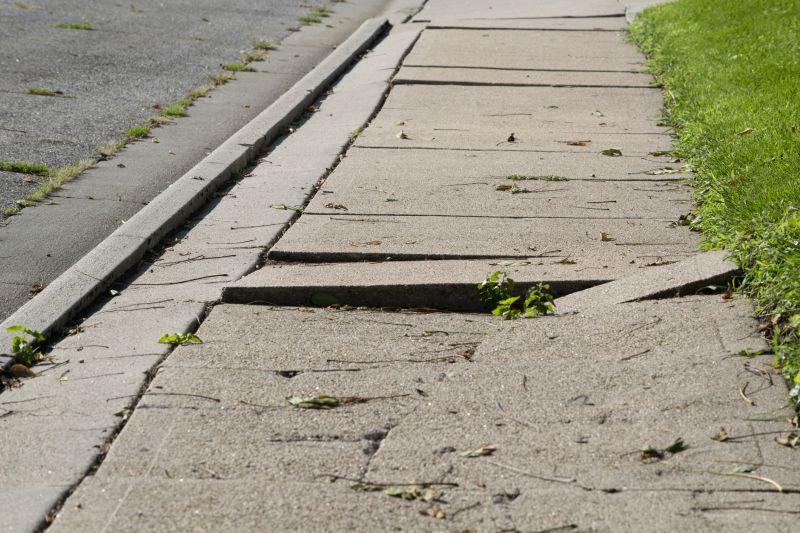Ultimate Guide to Sidewalk Crack Repair and Resurfacing Products
Find out which products are most effective for fixing cracks and resurfacing sidewalks to improve appearance and structural integrity.
 Sidewalk crack repair and resurfacing products are essential tools for maintaining the safety and appearance of paved walkways. Over time, sidewalks can develop cracks due to ground movement, temperature fluctuations, or aging materials. Addressing these issues promptly can prevent further deterioration and potential safety hazards. The market offers a wide variety of products designed to fill, seal, and restore concrete surfaces, each suited for different types of cracks and surface conditions. From simple patching compounds to advanced resurfacing overlays, there are solutions tailored to both DIY enthusiasts and professional contractors.
Sidewalk crack repair and resurfacing products are essential tools for maintaining the safety and appearance of paved walkways. Over time, sidewalks can develop cracks due to ground movement, temperature fluctuations, or aging materials. Addressing these issues promptly can prevent further deterioration and potential safety hazards. The market offers a wide variety of products designed to fill, seal, and restore concrete surfaces, each suited for different types of cracks and surface conditions. From simple patching compounds to advanced resurfacing overlays, there are solutions tailored to both DIY enthusiasts and professional contractors.
Top Overall Option
Concrete Crack Filler and Resurfacing Compound
A versatile and user-friendly product designed for filling cracks and resurfacing concrete surfaces. It provides a durable, weather-resistant finish suitable for various sidewalk conditions and is easy to apply with standard tools. Ideal for both small repairs and larger resurfacing projects, offering a seamless blend with existing concrete.
Types of Products For Sidewalk Crack Repair And Resurfacing
Liquid Crack Sealants
Flexible liquid compounds that seal cracks and prevent water infiltration, suitable for narrow or hairline cracks.
Polyurethane Foam Fillers
Expand to fill larger cracks and voids, providing a durable, flexible repair that accommodates slight ground movement.
Concrete Patching Compounds
Ready-mix or premixed compounds used to fill larger cracks and surface imperfections, offering a smooth finish.
Resurfacing Overlays
Thin layers of concrete or polymer-based materials applied over existing surfaces to restore uniformity and appearance.
Epoxy Concrete Repair Kits
High-strength epoxy formulations for structural repairs and crack filling, ideal for areas requiring additional durability.
Polymer-Modified Mortars
Enhanced mortars that bond well with existing concrete, used for repairing and resurfacing large areas.
Surface Sealers and Coatings
Protective layers that seal the surface, reducing water penetration and enhancing longevity.
Self-Leveling Compounds
Materials that flow and level out uneven surfaces, ideal for resurfacing and smoothing large cracks.
Rapid-Set Repair Mixes
Fast-curing compounds suitable for quick repairs, minimizing downtime and disruption.
Flexible Crack Fillers
Materials designed to move with the concrete, preventing new cracks from forming.
Popular Choices
Widely used for sealing and minor repairs, available in various formulations for different crack sizes.
Commonly chosen for restoring large sidewalk areas, providing a fresh look and surface protection.
Effective for filling deep or wide cracks, expanding to fill voids and stabilize the surface.
Convenient options for quick patching of surface imperfections and cracks.
Popular for structural repairs and filling cracks with high adhesion and strength.
Commonly used to protect repaired surfaces and extend the lifespan of sidewalks.
Favored for smoothing uneven surfaces and large cracks, creating a uniform finish.
Popular for quick fixes that require minimal downtime.
Chosen for their ability to accommodate slight ground shifts without cracking.
Choosing the right product depends on several factors, including the size and depth of the cracks, the extent of surface damage, and the desired finish. Some products are formulated for quick repairs, providing a durable seal that resists water infiltration and further cracking. Others are designed for resurfacing larger areas, offering a new surface layer that can improve the overall look and longevity of the sidewalk. Proper surface preparation is crucial for optimal results, which may involve cleaning, removing loose debris, and sometimes applying a bonding agent.
In addition to repair compounds, there are also tools and accessories that facilitate application, such as caulking guns, trowels, and surface rollers. Selecting the right combination of products and tools can make the repair process more efficient and produce a more professional appearance. Maintenance products like sealants and protective coatings can further extend the lifespan of sidewalk surfaces, helping to withstand weathering and foot traffic.
Overall, investing in high-quality sidewalk repair products can contribute significantly to the safety and aesthetic appeal of outdoor walkways. Whether addressing minor cracks or undertaking larger resurfacing projects, understanding the available options and proper application techniques is key to achieving durable and visually appealing results.
Key Buying Considerations
- Crack size and depth: Select products suitable for the specific dimensions of the cracks.
- Surface condition: Ensure the product adheres well to the existing concrete surface.
- Flexibility: Consider materials that can accommodate slight ground movements to prevent re-cracking.
- Curing time: Choose products with appropriate setting times based on project urgency.
- Durability: Look for formulations resistant to water, freeze-thaw cycles, and foot traffic.
- Ease of application: Evaluate whether the product can be applied with common tools and techniques.
- Finish appearance: Decide if a textured, matte, or smooth finish is desired after repair.
- Compatibility: Confirm that the product is compatible with existing concrete and repair materials.
- Weather conditions: Consider temperature and humidity requirements for optimal application.
- Cost and quantity: Balance budget constraints with the amount of material needed for the project.
- Environmental conditions: Avoid products that require prolonged curing in extreme weather.
- Sealing and finishing: Determine if additional sealants or coatings are necessary after repair.
- Long-term maintenance: Choose products that help reduce future repair needs.
- Safety and handling: Review safety instructions and handling requirements for the products.
This content may contain affiliate links. We earn commissions to support our work at no additional cost to you.
